Articles
- Page Path
- HOME > J Korean Acad Nurs > Volume 41(5); 2011 > Article
-
Original Article
- A Systematic Review of Psychological Distress as a Risk Factor for Recurrent Cardiac Events in Patients with Coronary Artery Disease
- Jin-Hee Park, Sun Hyoung Bae
-
Journal of Korean Academy of Nursing 2011;41(5):704-714.
DOI: https://doi.org/10.4040/jkan.2011.41.5.704
Published online: October 31, 2011
1Assistant Professor, College of Nursing, Ajou University, Suwon, Korea.
2Doctoral student, College of Nursing, Yonsei University, Seoul, Korea.
- Address reprint requests to: Bae, Sun Hyoung. Doctoral student, College of Nursing, Yonsei University, San 5 Wonchon-dong, Yeongtong-gu, Suwon 443-721, Korea. Tel: +82-31-219-7019, Fax: +82-31-219-7020, baega7695@hanmail.net
© 2011 Korean Society of Nursing Science
Abstract
-
Purpose
- The purpose of this study was to determine whether psychological distress is an independent risk factor for recurrent cardiac events in patients with coronary artery disease (CAD).
-
Methods
- A prospective cohort of studies that measured psychological distress and the incidence of recurrent cardiac events in the adult population were included. Three computerized databases were assessed (PubMed, CINAHL, and PSYCINFO). Meta-analysis was conducted using a random-effects model to determine summary estimates of risks of major recurrent cardiac events associated with each psychological distress. Of 506 publications identified, 33 met inclusion criteria, and 24 studies were used to estimate effect size of psychological distress on recurrent cardiac events.
-
Results
- Mean number in the research sample was 736 and mean time of follow-up was 4.0 years. Depression, anxiety, anger, and hostility as psychological factors were studied. According to estimation of effect size using random model effect, depression (OR=1.39, 95% CI: 1.22-1.57), anxiety (OR=1.22, 95% CI: 0.96-1.56), and anger/hostility (OR=1.29, 95% CI: 1.07-1.57) CAD patients in significantly increased risk for recurrent cardiac events.
-
Conclusion
- Finding suggests that psychological distress in forms of depression, anxiety, anger, and hostility impact unfavorably on recurrent cardiac events in CAD patients.
This work was supported by the National Research Foundation of Korea (KRF) funded by the Korea government (MEST) (2009-0065948).
- 1. Allison TG, Williams DE, Miller TD, Patten CA, Bailey KR, Squires RW, et al. Medical and economic costs of psychologic distress in patients with coronary artery disease. Mayo Clinic Proceedings. 1995;70:734–742. doi: 10.4065/70.8.734.ArticlePubMed
- 2. Barlow DH. Anxiety and its disorders. 2002;2nd ed. New York, NY, Guilford.
- 3. Barth J, Schumacher M, Herrmann-Lingen C. Depression as a risk factor for mortality in patients with coronary heart disease: A meta-analysis. Psychosomatic Medicine. 2004;66:802–813. doi: 10.1097/01.psy.0000146332.53619.b2.ArticlePubMed
- 4. Chida Y, Steptoe A. The association of anger and hostility with future coronary heart disease: A meta-analytic review of prospective evidence. Journal of the American College of Cardiology. 2009;53:936–946. doi: 10.1016/j.jacc.2008.11.044.ArticlePubMed
- 5. de Jonge P, Ormel J, van den Brink RH, van Melle JP, Spijkerman TA, Kuijper A, et al. Symptom dimensions of depression following myocardial infarction and their relationship with somatic health status and cardiovascular prognosis. The American Journal of Psychiatry. 2006;163:138–144. doi: 10.1176/appi.ajp.163.1.138.ArticlePubMed
- 6. Denollet J, Gidron Y, Vrints CJ, Conraads VM. Anger, suppressed anger, and risk of adverse events in patients with coronary artery disease. American Journal of Cardiology. 2010;105:1555–1560. doi: 10.1016/j.amjcard.2010.01.015.ArticlePubMed
- 7. DerSimonian R, Laird N. Meta-analysis in clinical trials. Controlled Clinical Trials. 1986;7:177–188. doi: 10.1016/0197-2456(86)90046-2.ArticlePubMed
- 8. Egger M, Davey Smith G, Schneider M, Minder C. Bias in meta-analysis detected by a simple, graphical test. British Medical Journal. 1997;315:629–634.ArticlePubMedPMC
- 9. Egger M, Smith GD, Altman DG. Systematic reviews of observational studies in Systematic Reviews in Health Care: Meta-Analysis in Context. 2001;2nd ed. London, BMJ Books.
- 10. Everson-Rose SA, Lewis TT. Psychosocial factors and cardiovascular diseases. Annual Review of Public Health. 2005;26:469–500. doi: 10.1146/annurev.publhealth.26.021304.144542.ArticlePubMed
- 11. Frasure-Smith N, Lesperance F. Depression and other psychological risks following myocardial infarction. Archives of General Psychiatry. 2003;60:627–636. doi: 10.1001/archpsyc.60.6.627.ArticlePubMed
- 12. Gorkin L, Schron EB, Brooks MM, Wiklund I, Kellen J, Verter J, et al. Psychosocial predictors of mortality in the Cardiac Arrhythmia Suppression Trial-1 (CAST-1). American Journal of Cardiology. 1993;71:263–267. doi: 10.1016/0002-9149(93)90788-E.ArticlePubMed
- 13. Higgins JP, Thompson SG, Deeks JJ, Altman DG. Measuring inconsistency in meta-analyses. British Medical Journal. 2003;327:557–560. doi: 10.1136/bmj.327.7414.557.ArticlePubMedPMC
- 14. Hopkins WG. An introduction to meta-analysis. Sportscience. 2004;8:20–24.
- 15. Kent LK, Shapiro PA. Depression and related psychological factors in heart disease. Harvard Review of Psychiatry. 2009;17:377–388. doi: 10.3109/10673220903463333.ArticlePubMed
- 16. Lemesle G, Sudre A, Modine T, Delhaye C, Rosey G, Gourlay T, et al. High incidence of recurrent in stent thrombosis after successful treatment of a first in stent thrombosis. Catheterization and Cardiovascular Interventions. 2008;72:470–478. doi: 10.1002/ccd.21709.ArticlePubMed
- 17. Leroy M, Loas G, Perez-Diaz F. Anhedonia as predictor of clinical events after acute coronary syndromes: A 3-year prospective study. Comprehensive Psychiatry. 2009;51(1):8–14. doi: 10.1016/j.comppsych.2009.01.011.ArticlePubMed
- 18. Lim ST. Assessment of prognosis and risk stratification in coronary artery disease. Nuclear Medicine and Molecular Imaging. 2009;43:222–228.
- 19. Martens EJ, Hoen PW, Mittelhaeuser M, de Jonge P, Denollet J. Symptom dimensions of post-myocardial infarction depression, disease severity and cardiac prognosis. Psychological Medicine. 2010;40:807–814. doi: 10.1017/S0033291709990997.ArticlePubMed
- 20. Mayou RA, Gill DM, Thompson DR, Hicks N, Volmink J, Neil A. Depression and anxiety as predictors of outcome after myocardial infarction. Psychosomatic Medicine. 2000;62:212–219. doi: 10.1017/S0033291709990997.ArticlePubMed
- 21. McCabe PJ. Psychological distress in patients diagnosed with atrial fibrillation: The state of the science. Journal of Cardiovascular Nursing. 2010;25:40–51. doi: 10.1097/JCN.0b013e3181b7be36.PubMed
- 22. Pedersen SS, Denollet J, de Jonge P, Simsek C, Serruys PW, van Domburg RT. Brief depression screening with the PHQ-2 associated with prognosis following percutaneous coronary intervention with paclitaxel-eluting stenting. Journal of General Internal Medicine. 2009;24:1037–1042. doi: 10.1007/s11606-009-1054-1.ArticlePubMedPMCPDF
- 23. Ridner SH. Psychological distress: Concept analysis. Journal of Advanced Nursing. 2004;45:536–545. doi: 10.1046/j.1365-2648.2003.02938.x.ArticlePubMed
- 24. Roest AM, Martens EJ, Denollet J, de Jonge P. Prognostic association of anxiety post myocardial infarction with mortality and new cardiac events: A meta-analysis. Psychosomatic Medicine. 2010;72:563–569. doi: 10.1097/PSY.0b013e3181dbff97.ArticlePubMed
- 25. Sirois BC, Sears SF Jr, Bertolet B. Biomedical and psychosocial predictors of anginal frequency in patients following angioplasty with and without coronary stenting. Journal of Behavioral Medicine. 2003;26:535–551. doi: 10.1023/A:1026201818892.ArticlePubMedPDF
- 26. Smith SC Jr, Allen J, Blair SN, Bonow RO, Brass LM, Fonarow GC, et al. AHA/ACC guidelines for secondary prevention for patients with coronary and other atherosclerotic vascular disease: 2006 update. Circulation. 2006;113:2363–2372. doi: 10.1161/CIRCULATIONAHA.106.174516.PubMed
- 27. Song EK, Son YJ, Lennie TA. Trait anger, hostility, serum homocysteine, and recurrent cardiac events after percutaneous coronary interventions. American Journal of Critical Care. 2009;18:554–561. doi: 10.4037/ajcc2009974.ArticlePubMedPMCPDF
- 28. Thune JJ, Signorovitch JE, Kober L, McMurray JJ, Swedberg K, Rouleau J, et al. Predictors and prognostic impact of recurrent myocardial infarction in patients with left ventricular dysfunction, heart failure, or both following a first myocardial infarction. European Journal of Heart Failure. 2011;13:148–153. doi: 10.1093/eurjhf/hfq194.ArticlePubMed
- 29. Ziegelstein RC, Thombs BD, Coyne JC, de Jonge P. Routine screening for depression in patients with coronary heart disease, never mind. Journal of the American College of Cardiology. 2009;54:886–890. doi: 10.1016/j.jacc.2009.01.082.ArticlePubMedPMC
REFERENCES
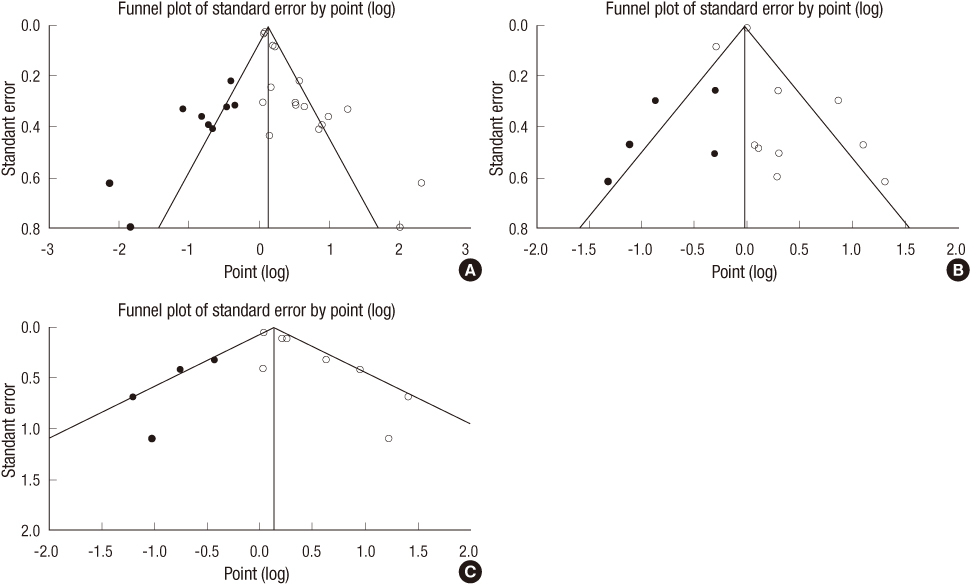
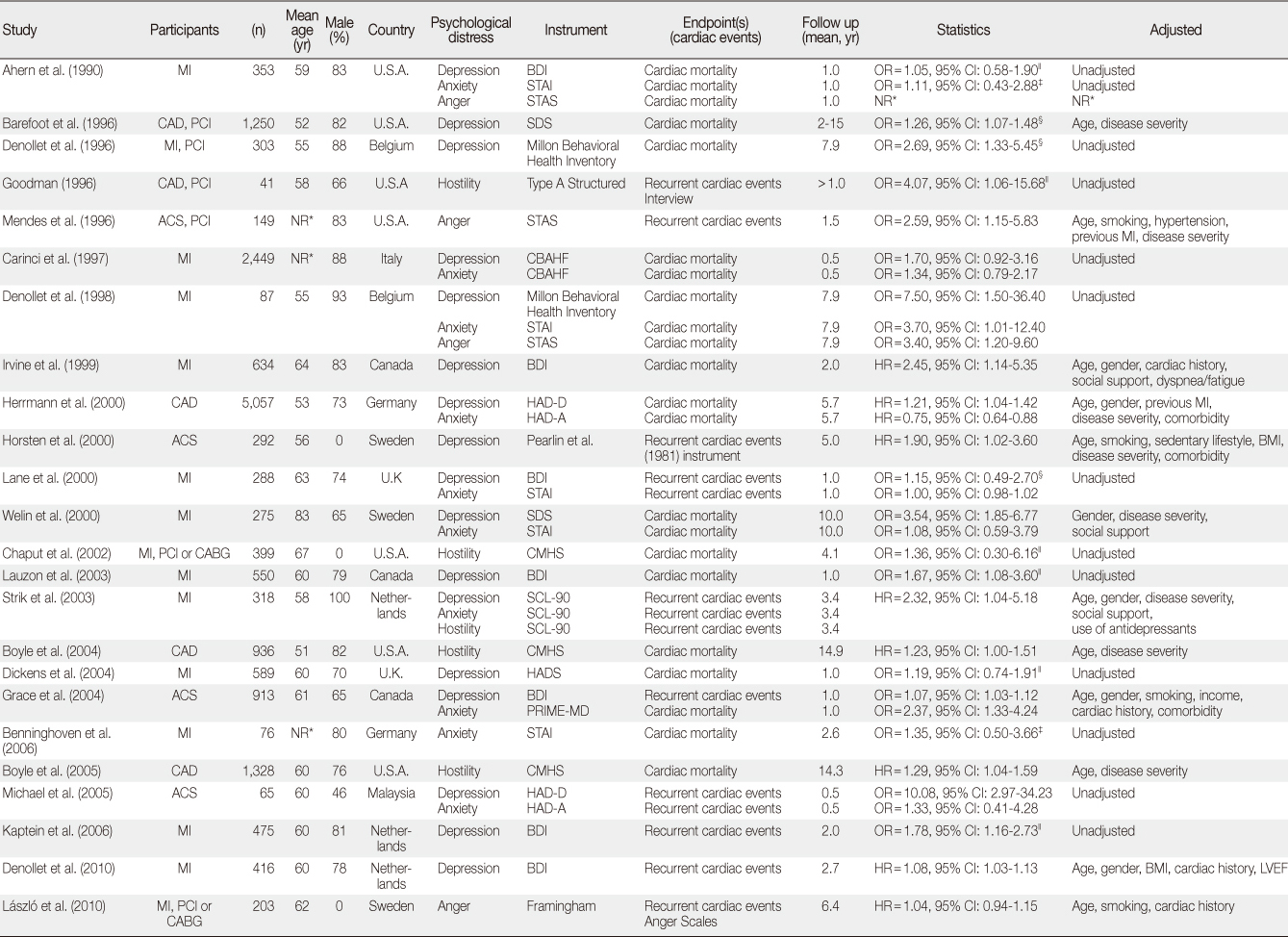
*NR, not reported; †NS, not specified; ‡Data received from Roest et al. (2010); §Data received from Barth et al. (2004); ∥Data calculated from Author.
ACS=Acute coronary syndrome; BDI=Beck depression inventory; BMI=Body mass index; CAD=Coronary artery disease; CABG=Coronary artery bypass graft; CBAHF=Cognitive behavioral assessment hospital form; CES-D=Center for epidemiologic studies depression scale; CMHS=Cook-Medley hostility scale; FHx=Family history; HADS=Hospital anxiety and depression scale; LVEF=Left ventricular ejection fraction; MI=Myocardial infarction; PCI=Percutaneous coronary intervention; S CL-90=Symptom check list-90; SDS=Zung self-rating depression scale; STAI=State trait anxiety inventory; STAS=State-trait anger scale.
Figure & Data
REFERENCES
Citations

- NAMS task force report on mental stress
Rajesh Sagar, Kaushik Chatterjee, Sandeep Thareja, Anurag Timothy, A.S. Yadav, Prateek Yadav, Rajinder Dhamija, S.V. Madhu, Preethy Kathiresan, Pratibha Prasad, Swati Kedia Gupta, Kalpana Srivastava
Annals of the National Academy of Medical Sciences (India).2025; 61: 66. CrossRef - Impact of Type D Personality and Health Literacy on Resilience of Inpatients with Cardiovascular Diseases: A Cross-Sectional Study
Da Eun Kim, Seon Young Hwang
Korean Journal of Adult Nursing.2023; 35(1): 23. CrossRef - The Effect of Perceived Stress, Fine Dust Risk Perception, and Resilience on Stress Response in Patients with Respiratory and Circulatory Disorders
Jin-Hee Park, Kuem-Sun Han
STRESS.2021; 29(1): 21. CrossRef - Associations of depression and anxiety with cardiovascular risk among people living with HIV/AIDS in Korea
Kyong Sil Park, Seon Young Hwang, Bo Youl Choi, June Kim, Sang Il Kim, Woo-Joo Kim, Chun Kang
Epidemiology and Health.2020; 43: e2021002. CrossRef - Impact of Type D Personality on Depression, Anxiety, and Health-related Quality of Life among Coronary Artery Disease Patients: A Systematic Review and Meta-analysis
Sun Hyoung Bae, Jin-Hee Park
Korean Journal of Adult Nursing.2019; 31(3): 219. CrossRef - Analysis of the relationship between community characteristics and depression using geographically weighted regression
Hyungyun Choi, Ho Kim
Epidemiology and Health.2017; 39: e2017025. CrossRef - Influencing Effects of Type D Personality on Symptom Experiences and Quality of Life in Patients with Percutaneous Coronary Intervention
Eun Hee Jo, Sun Hee Han, Myung Ha Lee, Sung Reul Kim
Korean Journal of Adult Nursing.2016; 28(5): 536. CrossRef - Depression and Anxiety as Predictors of Recurrent Cardiac Events 12 Months After Percutaneous Coronary Interventions
Jin-Hee Park, Seung-Jea Tahk, Sun Hyoung Bae
Journal of Cardiovascular Nursing.2015; 30(4): 351. CrossRef - Anger, anger expression, cardiovascular risk factors, and gastrointestinal symptoms by hwa-byung symptoms in Korean adult women
Young-Joo Park, Sook-Ja Lee, Nah-Mee Shin, Hyunjeong Shin, Hyun Cheol Kang, Yoon Tae Jin, Song I. Jeon, Inhae Cho
Applied Nursing Research.2015; 28(4): 398. CrossRef - Risk Factor–tailored Small Group Education for Patients with First-time Acute Coronary Syndrome
Seon Young Hwang, Jin Shil Kim
Asian Nursing Research.2015; 9(4): 291. CrossRef - Influences of Knowledge, Self-efficacy, and Social Support on Sick Role Behavior in Patients with Coronary Artery Disease
Soonhee Kim, Sunhee Lee
Journal of Korean Public Health Nursing.2014; 28(2): 228. CrossRef - Factors Influencing the Quality of Life in Low- Income Elders Living at Home: A Literature Review
Chung-Min Cho
Journal of Korean Public Health Nursing.2013; 27(2): 372. CrossRef - Effects of a psychoeducational intervention for secondary prevention in Korean patients with coronary artery disease: A pilot study
Jin‐Hee Park, Seung‐Jae Tahk, Sun Hyoung Bae, Youn‐Jung Son
International Journal of Nursing Practice.2013; 19(3): 295. CrossRef - Stress and cardiovascular disease
Jung Jin Cho
Journal of the Korean Medical Association.2013; 56(6): 462. CrossRef
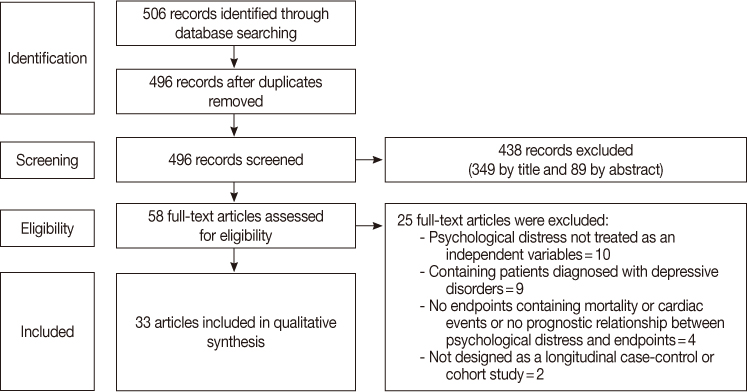
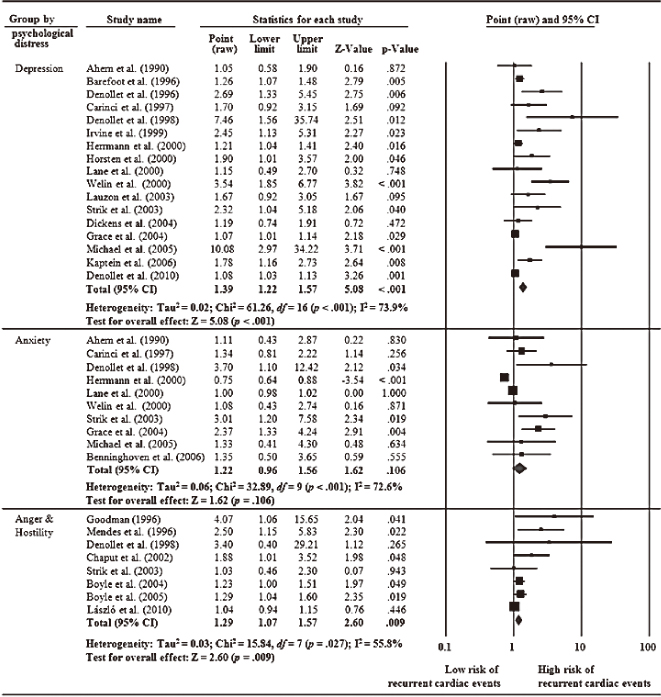

Figure 1
Figure 2
Figure 3
Results of the Quality Assessment of Selected Studies (N=33)
Y=Yes; N=No; ?=Not sure; C=Calculated; I=Implied; NR=No relevance.
Characteristics Presented in 33 Studies (N=33)
*multiple assessment included.
Characteristics of Selected Studies for Effect Size Extraction (N=24)
*NR, not reported; †NS, not specified; ‡Data received from Roest et al. (2010); §Data received from Barth et al. (2004); ∥Data calculated from Author.
ACS=Acute coronary syndrome; BDI=Beck depression inventory; BMI=Body mass index; CAD=Coronary artery disease; CABG=Coronary artery bypass graft; CBAHF=Cognitive behavioral assessment hospital form; CES-D=Center for epidemiologic studies depression scale; CMHS=Cook-Medley hostility scale; FHx=Family history; HADS=Hospital anxiety and depression scale; LVEF=Left ventricular ejection fraction; MI=Myocardial infarction; PCI=Percutaneous coronary intervention; S CL-90=Symptom check list-90; SDS=Zung self-rating depression scale; STAI=State trait anxiety inventory; STAS=State-trait anger scale.
Y=Yes; N=No; ?=Not sure; C=Calculated; I=Implied; NR=No relevance.
*multiple assessment included.
*NR, not reported; †NS, not specified; ‡Data received from Roest et al. (2010); §Data received from Barth et al. (2004); ∥Data calculated from Author. ACS=Acute coronary syndrome; BDI=Beck depression inventory; BMI=Body mass index; CAD=Coronary artery disease; CABG=Coronary artery bypass graft; CBAHF=Cognitive behavioral assessment hospital form; CES-D=Center for epidemiologic studies depression scale; CMHS=Cook-Medley hostility scale; FHx=Family history; HADS=Hospital anxiety and depression scale; LVEF=Left ventricular ejection fraction; MI=Myocardial infarction; PCI=Percutaneous coronary intervention; S CL-90=Symptom check list-90; SDS=Zung self-rating depression scale; STAI=State trait anxiety inventory; STAS=State-trait anger scale.
 KSNS
KSNS
 E-SUBMISSION
E-SUBMISSION



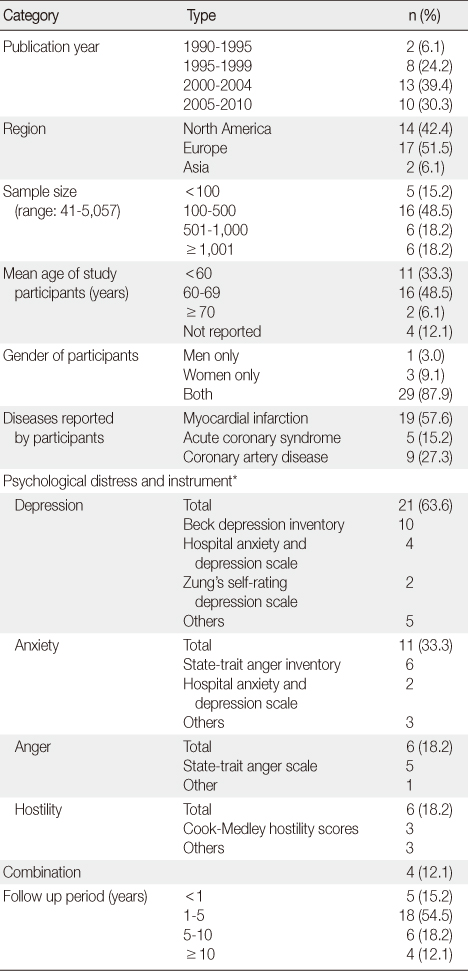
 Cite
Cite

